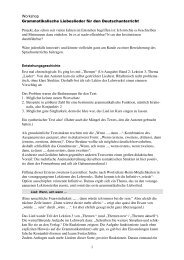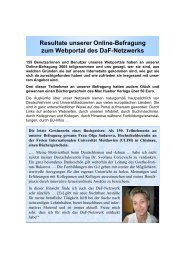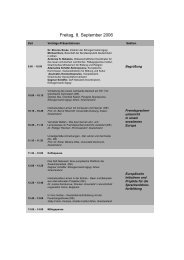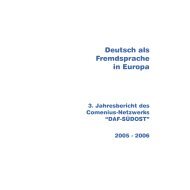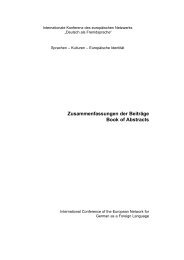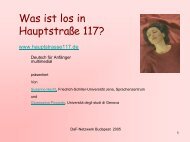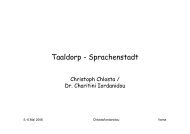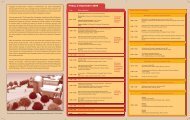Fremdsprache Deutsch Europäisch - DaF Netzwerk
Fremdsprache Deutsch Europäisch - DaF Netzwerk
Fremdsprache Deutsch Europäisch - DaF Netzwerk
Erfolgreiche ePaper selbst erstellen
Machen Sie aus Ihren PDF Publikationen ein blätterbares Flipbook mit unserer einzigartigen Google optimierten e-Paper Software.
144<br />
<strong>Fremdsprache</strong> <strong>Deutsch</strong> <strong>Europäisch</strong><br />
students during their language studies and consequently have not been confronted with related<br />
model teacher behaviour nor have they had opportunities to develop personal perspectives on<br />
language learning and teaching in such a context. Next to other obstacles to the use of the<br />
new media in (English) language teaching such as the digital divide (computer access) Müller-<br />
Hartmann & Schocker-von Ditfurth (2004: 143-144) state that ‘One of the most pressing<br />
needs in this regard is the qualification of teachers in pre- and in-service training in combination<br />
with school development’.<br />
A recent study (Bonnet, 2002) involving 561 teachers in eight EU-countries showed among<br />
other things that:<br />
- only a small percentage (less than 31%) of practicing teachers attend in-service courses<br />
- internet and language learning software are very rarely used (reported by 47% and 64%<br />
of the respondents respectively)<br />
- in a number of countries (Netherlands, Spain, Finland) the use of the target language<br />
in class is at a low level (e.g. 90 % of Dutch teachers use L2 half or less of the time<br />
during lessons)<br />
- less than 50% make use of role-plays or communicative situations<br />
- activities that involve L2 use in real situations are very rarely (70% ) organised; only<br />
4% report to sometime use internet based discussion.<br />
Confronted with these findings a group of some 30 experts and policy makers at the conference<br />
‘Improving Language Education’ 7 focussing on ‘Stimulating and maintaining teacher<br />
professionalism’ reported a number of concerns and urgent needs for improvement<br />
(Westhoff, 2004):<br />
- closer cooperation between teacher training institutes and schools (to address the<br />
theory vs. practice issue)<br />
- adoption of innovative teaching methods (e.g. use of media, international exchanges)<br />
- more cooperation and networking between teacher training organisations<br />
- promotion of life long learning and participation in in-service training (e.g. by using<br />
e-learning)<br />
In the majority of the current teacher preparation programmes students are at best informed<br />
about telecollaboration but they lack the practical experiences necessary for the development<br />
of the relevant teacher competences. Yet, to be able to meet the demands of the networkbased<br />
classroom they will need the competences to arrange and facilitate project based student<br />
learning with the help of web tools and portals. For a description of practices in teacher<br />
education designed to address these issues see (Legutke, 2003).<br />
The opportunities the second-generation web technologies offer (Godwin-Jones, 2003) to<br />
remedy constraints in current language education provision are being emphasised by an<br />
increasing number of second language acquisition researchers. Illustrations of, respectively,<br />
7 The Netherlands hosted this working conference as part of the Dutch EU-presidency in 2004. It was<br />
attended by professionals, experts and representatives of Ministries of Education from almost all EU<br />
Member States



